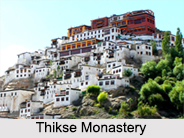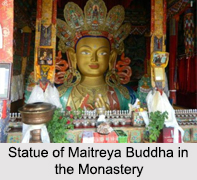 Situated on a hillock at an altitude of 3,600 metres, the Thikse Monastery stands majestically overlooking the Indus Valley with the view of the magnificent Stok Range. It is the largest gompa in the region and resembles the Potala Palace which is located in Tibet. The Thikse Monastery is affiliated to the Gelugpa or the Yellow Hat sect of Buddhism and is famous for its 49 feet tall statue of Maitreya Buddha sitting in lotus position, covering 2 floors of the monastery.
Situated on a hillock at an altitude of 3,600 metres, the Thikse Monastery stands majestically overlooking the Indus Valley with the view of the magnificent Stok Range. It is the largest gompa in the region and resembles the Potala Palace which is located in Tibet. The Thikse Monastery is affiliated to the Gelugpa or the Yellow Hat sect of Buddhism and is famous for its 49 feet tall statue of Maitreya Buddha sitting in lotus position, covering 2 floors of the monastery.
History of Thikse Monastery
The Thikse Monastery was founded in the early 15th century by Palden Zangpo along-with his master Jangsem Sherab Zangpo, who were one of the six contemporary disciples of Lord Tsong Khapa. He was the founder of the Gelugpa school of Tibetan Buddhism and sent out his disciples for the dissemination of his teachings in the remote parts where the disciples founded the Thikse Monastery. Tsong Khapa once prophesied that his doctrine would flourish along the right side of the Indus River and his prophecy came to realization with the establishment of the first Gelugpa monastery at Thikse followed by many other monasteries of the same order such as the Spituk and the Likir monasteries, which were also located on the right bank of the river.
According to legend, it is said that Sherab Zangpo along with Palden Zangpo were performing some sacred rituals with some torma offerings, which are basically offerings used in Tibetan Buddhism made of butter and flour. The torma offerings were taken to a rock outcrop to be thrown down the valley and as they were about to do that 2 crows appeared and carried away the ceremonial plate with the torma offerings. Sherab Zangpo and his disciple Palden Zangpo reached the village of Thikse on the other side of the hill where they saw the torma placed on a stone in perfect order and in an undisturbed condition. They took it to be an auspicious sign, and decided to build a monastery at that very spot. The name of the monastery, Thiksey, which means "perfect order", is derived from the perfect order in which the crow placed the torma.
Structures of Thikse Monastery
The buildings of the Thikse Monastery are arranged in an ascending order of importance and are well spaced, from the foot of the hill housing the dwelling units to the top of the hill enshrining the monasteries and the potang, the official residence of the chief lama. The monastery precinct at the foot of the hill has a courtyard from where a flight of steps leads to the main monastery which is 12 stories in height and has 2 main chambers. The monastery is painted in red, ochre and white and houses 60 lamas and attached to it is a nunnery. Presently, the nunnery houses 26 nuns and is known as chomos or the female religious practitioners.
One of the main points of interest in the Thikse Monastery is the Maitreya Temple, which was erected to commemorate the visit of the 14th Dalai Lama in the year 1970. The high statute of Maitreya Buddha is the largest statue in Ladakh and took about 4 years to build. The statue was made with clay, gold paint and copper by the local artists under the master Shilp Guru Nawang Tsering of Central Institute of Buddhist Studies. At the entrance to the monastery, there are big stupas and mani walls and the entire monastery complex has a number of white washed huts, which houses the Lamas.
 The monastery has a main prayer hall, where the walls depict the murals of Tibetan calendar, the deities of Mahakala and Sitatapatra and the symbol of Wheel of Life. The wheel has insignia images of a snake, a bird and a pig that signify ignorance, attachment, and aversion. The purpose of this depiction is meant to remind that these earthly ties need to be overcome in order to get enlightenment in life and to prevent the cycle of death and rebirth. The hall also has an image of the 1000 armed Avalokitesvara with Padmasambhava. And in the centre is a seat for the Dalai Lama and to its right, for the head lama and to its left, another deity is pictured. There are also wooden shelves in the walls that houses the 225 volumes of the Tengyur wrapped in silk. There are also murals in the courtyard depicting images of Tsong Khapa, Lord Buddha and Palden Lhamo.
The monastery has a main prayer hall, where the walls depict the murals of Tibetan calendar, the deities of Mahakala and Sitatapatra and the symbol of Wheel of Life. The wheel has insignia images of a snake, a bird and a pig that signify ignorance, attachment, and aversion. The purpose of this depiction is meant to remind that these earthly ties need to be overcome in order to get enlightenment in life and to prevent the cycle of death and rebirth. The hall also has an image of the 1000 armed Avalokitesvara with Padmasambhava. And in the centre is a seat for the Dalai Lama and to its right, for the head lama and to its left, another deity is pictured. There are also wooden shelves in the walls that houses the 225 volumes of the Tengyur wrapped in silk. There are also murals in the courtyard depicting images of Tsong Khapa, Lord Buddha and Palden Lhamo.
Within the monastery premises there is also a temple dedicated to Goddess Tara with her 21 images placed in glass-covered wooden shelves. Small shrines devoted to several guardian divinities including Cham-spring, the protector deity of Thikse, can also be seen between the main courtyard and the staircase. On the top floor of the monastery is a place where only men are allowed to enter as it houses the Lamokhang temple, which is a repository of numerous volumes of scriptures including Kangyur and Stangyur. This floor is also the official residence of the incarnate lama of the monastery. There is a small room above the temple which is exclusively used as a school room to teach the local boys of the village, and out of these boys some are even chosen as Lamas. A large pillar engraved with the Buddha`s teachings is also located here.
Currently, at the request of the concerned Monastery administration, the Archaeological Survey of India is restoring the ancient monastery of Thikse, along-with several other monasteries in Ladakh. The traditional mud and stone courtyards has now been changed to granite, which has apparently marred the brightness of the place. The restoration of the right wing of the monastery along with the construction of the new kitchen and dining hall for the monks by replacing the old traditional central courtyard has spurred some controversy.
Festivals at Thikse Monastery
An annual festival called the Gustor Festival is held in this monastery from the 17th to the 19th day of the 9th month of the Tibetan calendar. Sacred dances such as the mask dance or the Cham dance are performed as part of this festival. Another special feature is the trade fair held at the base of the monastery, in which villagers from all over Ladakh assemble to barter and trade items and socialize. There are also sand mandalas which are made for smaller festivals.
Visiting Information on Thikse Monastery
The nearest railway station is at Jammu Tawi at a distance of 700 km from the village of Thikse. The Kushok Bakula Rimpochee Airport at Leh is about 18 km from Thikse.



















